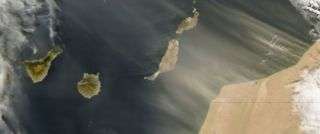Dusty Hurricanes

Throw gasoline on a fire, and the flames swell to a raging inferno. Throw dirt on a fire, and the flames suffocate. But what happens when you throw dirt on a hurricane? It's a serious question.
Hurricanes are born in Atlantic waters just off the west coast of Africa. Thunderstorms gather there and, sometimes, for reasons no one fully understands, they merge into swirling monster storms that can cross the ocean to hit the United States thousands of miles away.
The place where hurricanes are born is very close to the Sahara desert—a prodigious source of fine dirt and dust—and Sahara dust storms can blow right into the hurricane genesis region. What does all that dry, dusty air do to a baby hurricane? This is a mystery of hurricane science.
"There are at least two possibilities," notes Bill Lapenta, an atmospheric scientist from NASA's Marshall Space Flight Center. On one hand, dust might strengthen a hurricane. Dust grains serve as nucleation points for clouds and raindrops. This could cause a young storm to intensify because rain is a key part of a hurricane's internal "heat engine." On the other hand, dry, dusty air might have the opposite effect, choking off a storm's development by altering atmospheric circulation patterns normal to a growing storm.
Which theory is true? Lapenta and colleagues recently gathered data that brings them closer to the answer. They did it by flying directly into a dusty hurricane.
Along with dozens of other scientists, Lapenta spent last fall in the Cape Verde Islands off the west coast of Africa. Their mission: to catch hurricanes in the act of being born. The name of the expedition was NASA African Monsoon Multidisciplinary Analyses—or NAMMA for short. NAMMA researchers monitored the ocean near Cape Verde for promising clusters of thunderstorms, and when they saw a group gathering into a potential hurricane, they sprang into action. NASA's DC-8 Airborne Laboratory flew in and around the storms equipped with instruments to measure wins, water vapor, moisture, atmospheric pressure and temperature. NASA and NOAA satellites, weather balloons and ground-based radar gathered even more data.
"We sampled one particular storm two days in a row," recalls Lapenta. "On the first day, our instruments detected very little dust in the storm system. It was clean and pristine. But the next day, using the same aircraft and the same instruments, we detected lots of dust." From one day to the next, the storm system had behaved like a dust mop, swooping up tiny particles from the atmosphere and pulling them in.
What happened next? The storm eventually went on to form a category three hurricane, Helene, one of the strongest of the 2006 Atlantic hurricane season.
So dust promotes hurricanes, right? Lapenta isn't ready to leap to that conclusion. "It's a very complicated problem," he explains. "Dust is one factor in hurricane formation, but there are many others, too." Atmospheric winds, humidity, sea-surface temperature—they all play a role. The effect of dust may be "situation dependent," meaning it depends on what the rest of the atmosphere is doing when the dust hits. "We're still analyzing our data to get the whole picture," he says.
So long after the aircraft has landed, the study continues. NAMMA is a three-year mission, with the first year dedicated to field research, followed by two years of data-analysis.
Source: by Sherrie Super and Dr. Tony Phillips, Science@NASA





















